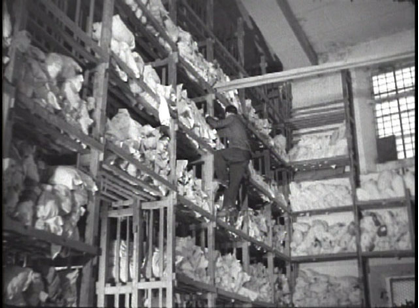A broken world of bedsheets and bicycles
In “What Novels Can Do That Films Can’t (And Vice Versa),” Seymour Chatman argues that in film, “the dominant mode is presentational, not assertive. A film doesn’t say, ‘This is the state of affairs,’ it merely shows you that state of affairs.”
Consider a key scene in Vittorio De Sica’s 1948 Ladri di Bicyclette (Bicycle Thieves). Antonio Ricci, the protagonist, takes his wife Maria to pawn their bedsheets, in order to reclaim his in-hock bicycle, which he needs for a new job. The sheets are part of Maria’s trousseau or dowry gift. They’re not Antonio’s to give.
By trading the sheets for the bicycle, the Riccis exchange one overdetermined object for another, belonging to economies separated according to exterior and interior, male and female, future and past. All they share is a common exchange-value. But more is required than just swapping them for money: the objects themselves must be transformed, made as abstract as money itself.
Maria removes the sheets from the bed, washes them, and bundles them up. (“Trousseau” literally means “truss” or “bundle.”) She also negotiates their exchange, and convinces the counter employee to pay 7500 rather than 7000 lire. But this is crucial: they’re not sold. Instead, they’re collateral for a loan, just as Antonio’s bicycle was. The intent is always to buy them back with his new wages.
Antonio has a receipt for his bicycle, and reclaims it from another clerk at another window. As he walks away from the camera to match the number on the receipt with the number on the bicycle, we nearly miss another employee crossing in front. Here the script reads (in English translation): “In the foreground, a man with a bundle of sheets, passes.” We have no way of knowing whether these are Maria’s, although we are asked to associate this scene with the rest of their story.
 “Pan with him until he reaches a beehive of sheets filled from floor to ceiling with sheets,” the script continues. “With some skill he climbs about half-way up the wall of shelves where he deposits the newly arrived bundle.”
“Pan with him until he reaches a beehive of sheets filled from floor to ceiling with sheets,” the script continues. “With some skill he climbs about half-way up the wall of shelves where he deposits the newly arrived bundle.”
The script does not specify the height or breadth of the wall, or the number of shelves; in the film the wall is preposterously huge, probably thirty feet high. No other set on the film (with the possible exception of the market at the Plaza Vittorio) is nearly as elaborately or dramatically built. The shelves make approximately 3’ by 5’ units that sprawl around the room, extending off-camera in both directions, each crammed with dozens of bundles.
The economic gambit Antonio and Maria have made is simple: exchange the trousseau for the bicycle, the bicycle for the job, which will in turn allow them to reclaim the trousseau. The sheer number of trousseaus is evidence that this economy, like so many of the other economies of misery encountered in the film — the employment office, the police station, the workers’ guild, the market, the church — is broken. As Mark West writes, “the whole country seems to have hocked great masses of household goods.” What’s received never adds up to what is paid; victims must track down their own stolen goods, which in turn are brought to market, but never sold.
The size of the wall, especially in contrast to the small, neat row of bicycles, suggests less orderly classification than the impossibility of comprehension. Narrative film collapses into pure photography. The futility of containing the entire shot within the frame, even with a panning camera, mirrors the futility of Antonio and Maria’s situation. It does not matter at all whether the particular bundle being carefully (or not so carefully) stowed away belongs to them.
The personal narrative of pawning the trousseau and reclaiming the bicycle is unmasked as a potentially infinite iteration. There is nothing irreplaceable about this family: the story of Bicycle Thieves could belong to anyone.
Indeed, after the bicycle is stolen, after a fruitless search, Antonio himself is caught at the end of the film stealing a lone bicycle. This is why the film has the plural title Ladri di bicyclette. There isn’t only one thief in the film, but many; not one story of loss, but countless stories that go untold.
In many ways, though, I still prefer the mistranslation Bicycle Thief, which is how you will find the film listed on Netflix, to the more literal Bicycle Thieves. The key is to see it not as a definite reference, but an abstract position anyone might occupy given the right circumstances.
There are no collective nouns — just a series of isolated and interchangable parts. That’s the story Antonio’s bicycle and Maria’s bedsheets tell in their own fragmented way.
—
Tim Carmody is a technology and media writer for Wired and Wired.com, recovering academic, and resident bookfuturist at Snarkmarket.